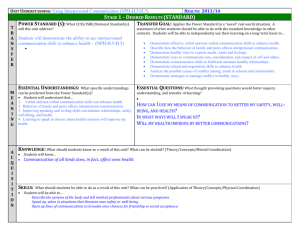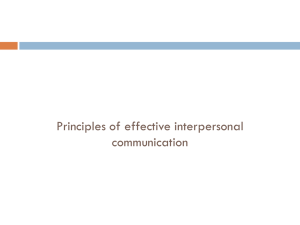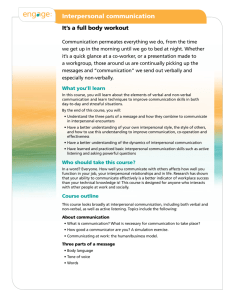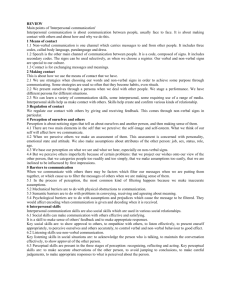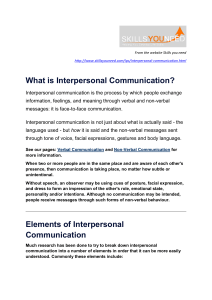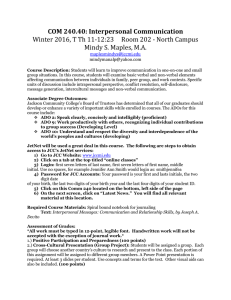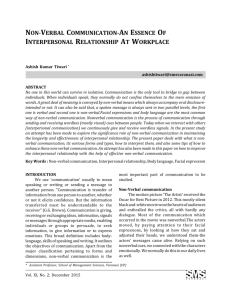Service Learning & Group Dynamics Packet
advertisement
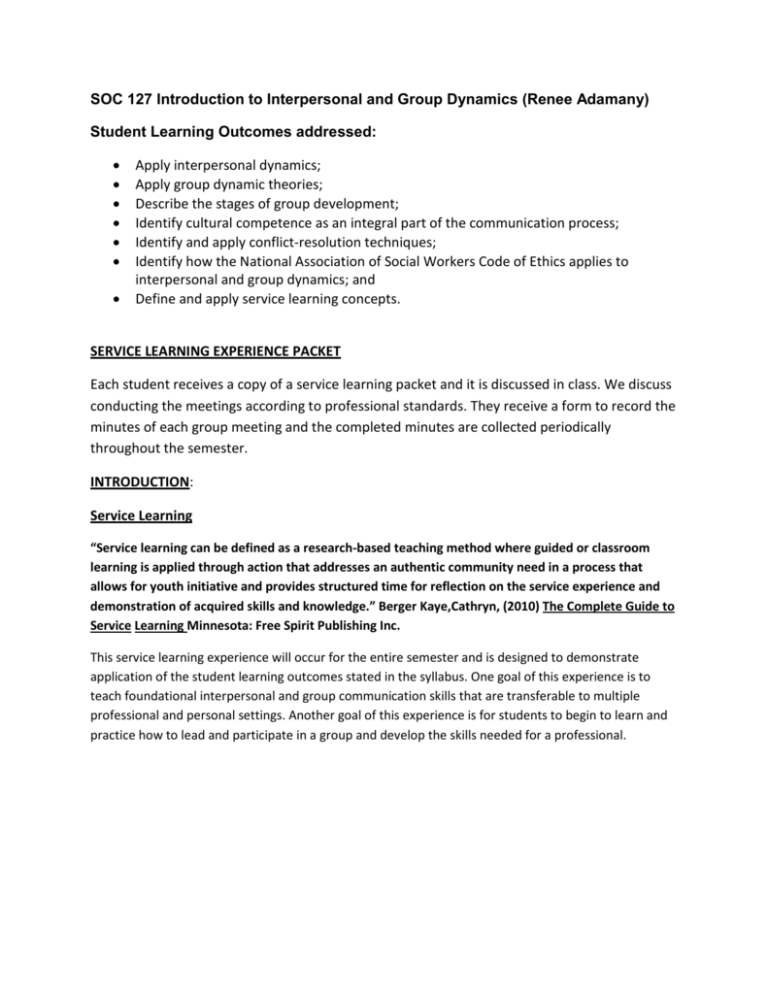
SOC 127 Introduction to Interpersonal and Group Dynamics (Renee Adamany) Student Learning Outcomes addressed: • • • • • • • Apply interpersonal dynamics; Apply group dynamic theories; Describe the stages of group development; Identify cultural competence as an integral part of the communication process; Identify and apply conflict-resolution techniques; Identify how the National Association of Social Workers Code of Ethics applies to interpersonal and group dynamics; and Define and apply service learning concepts. SERVICE LEARNING EXPERIENCE PACKET Each student receives a copy of a service learning packet and it is discussed in class. We discuss conducting the meetings according to professional standards. They receive a form to record the minutes of each group meeting and the completed minutes are collected periodically throughout the semester. INTRODUCTION: Service Learning “Service learning can be defined as a research-based teaching method where guided or classroom learning is applied through action that addresses an authentic community need in a process that allows for youth initiative and provides structured time for reflection on the service experience and demonstration of acquired skills and knowledge.” Berger Kaye,Cathryn, (2010) The Complete Guide to Service Learning Minnesota: Free Spirit Publishing Inc. This service learning experience will occur for the entire semester and is designed to demonstrate application of the student learning outcomes stated in the syllabus. One goal of this experience is to teach foundational interpersonal and group communication skills that are transferable to multiple professional and personal settings. Another goal of this experience is for students to begin to learn and practice how to lead and participate in a group and develop the skills needed for a professional. Explanation of Group Meeting format GROUP ROLES: GROUP LEADER/MEMBERS: The leader for each group will be chosen in collaboration with the group and the professor. The leader is responsible for leading the meetings and functioning as the contact person. However, all the members of the group are expected to share the work equally. The individual grade of each member depends on his/her individual role. • Before the first meeting a leader will be chosen. The following is the criteria for being a group leader. If the professor knows that a particular student in a group has the skills to be the group leader and he/she would enjoy leading, he/she may be the leader. If all of the members are unknown to the professor, the criteria listed below will be used to choose the group leader. The leader must have completed 30 college credits. The leader needs to possess the following: previous supervisory experience or group leadership experience, the ability to relate to a variety of personalities, conflict management skills, flexibility, organization, and the ability to multi-task. The group will agree on the chosen group leader. • Arrive at the meeting prepared to lead. All members of the group will read the chapter on group leadership before the meeting. The purpose of this reading is to increase members understanding of the skills required to be an effective leader. • Be conscious of your communication style, both verbal and non-verbal as well as the communication style of the group. • Leader- Arrive prepared with techniques on how to motivate the group. Arrive prepared with a specific plan how to begin, conduct and end the meeting. GROUP SECRETARY: During each group session the role of secretary will be rotated so that each student assumes this role at least once. The minutes will be recorded on a group reporting form and kept in the group folder, to be kept by the group leader. MEETINGS MEETING ONE AND TWO: The purpose of this meeting will be to become acquainted with each other, brainstorm ideas and begin to formulate the details of the service learning experience. • • • • • The professor will lead the group in this introductory session. The members of the group will begin to plan how and who will INVESTIGATE and RESEARCH the specific needs of the organization they have chosen for their service learning experience. The professor will provide contact information if that information is known. When the experience is decided upon, create a title. Make the title “SNAPPY!!!” Create a master list of names, phone numbers and e-mail. Give this list to the professor to be duplicated and distributed to the group. Decide who will be the secretary for the next meeting. Each person will assume the role of secretary for a minimum of one meeting. SUBSEQUENT MEETINGS: These meetings will include time for preparation and planning, action, reflection and planning for the group presentation. Some of these meetings will occur during class time and some will occur outside of the regularly scheduled class time. As a group, choose a series of regular dates and times to meet. If an EMERGENCY situation arises, please notify the group leader BEFORE the meeting. The leader will keep the attendance for each meeting. It is expected that when a member agrees to a time she/he will be responsible for participating in that meeting. Meetings that occur outside of the class time are to be recorded on the forms and kept in the official group folder. GROUP PRESENTATION OF THE SERVICE LEARNING EXPERIENCE The students are expected to present as a group their service learning experience. This presentation is also part of the celebration step of service learning. The students listening to the presentation complete a sheet answering questions on the group’s use of verbal and non-verbal communication skills, their conflict resolution techniques and other information as related to service learning. Each student presenting is graded individually according to oral presentation rubrics, which they receive in advance of the presentation. Oral Presentation Instructions Each group will deliver a 20-30 minute presentation. Each group member will present on one or more of the topics listed below. The presentation will include the information listed below and will be graded accordingly. Please incorporate power point, visuals such as pictures, and/or brochures or other ideas that will make the presentation INTERESTING and SNAPPY!!! INTRODUCTION • • Introduce the members of the group. State the name of the experience. BODY OF THE PRESENTATION • • • • • Identify and discuss the need that the experience addressed. Discuss the mission and the purpose of the organization where you conducted the service learning experience. Discuss how you discovered, analyzed and researched the causes of this need. Explain how the lives of others improved because of this experience. Each person will analyze and describe specifically what they learned from this experience. You will also state what specifically you contributed to this experience. Include what communication skills you learned and how your communication skills improved. GROUP PROCESS • • • • Describe the composition of the members of the group in terms of ethnicities, communication styles and other topics from both books. Describe the group process in terms of developing goals, interdependence, trust, communication, how conflict was managed, how decisions were made and other key processes of the group. Discuss what the group might have done differently. Each person will also state individually, what she/he may have done differently. FINAL EXAM The final exam is measurement of all the SLO’s The final exam is also a reflection tool which is a service learning stage. The exam is graded with a rubric. PART 1 • Describe your verbal communication style and what you learned about yourself during your service learning experience. Discuss the skills that you learned and/or improved. Include the skills that you need to improve. • Describe your non-verbal communication style and what you learned about yourself during your service learning experience. Discuss the skills that you learned and/or improved. Include the skills that you need to improve. • Describe and discuss your specific contributions to the group. • Describe what you might have done differently in the group. (i.e. how could you have improved the functioning of the group? How could you have made this project more successful?) PART 2 • • Define Tuckman’s stages and give an example of how your group followed each stage within the service learning experience. Discuss the challenges that your service learning group experienced in regards to conflict. Discuss what conflict resolution techniques were applied to these challenges. PART 3 • Describe and discuss the cultural factors in your group and how they impacted your group and service learning experience. PART 4 • Define and describe how one of the National Association of Social Workers Code of Ethics principles was applied. PART 5 • • Define and explain the service learning steps. Describe how your group implemented each step. Provide examples of the implementation of each step.
